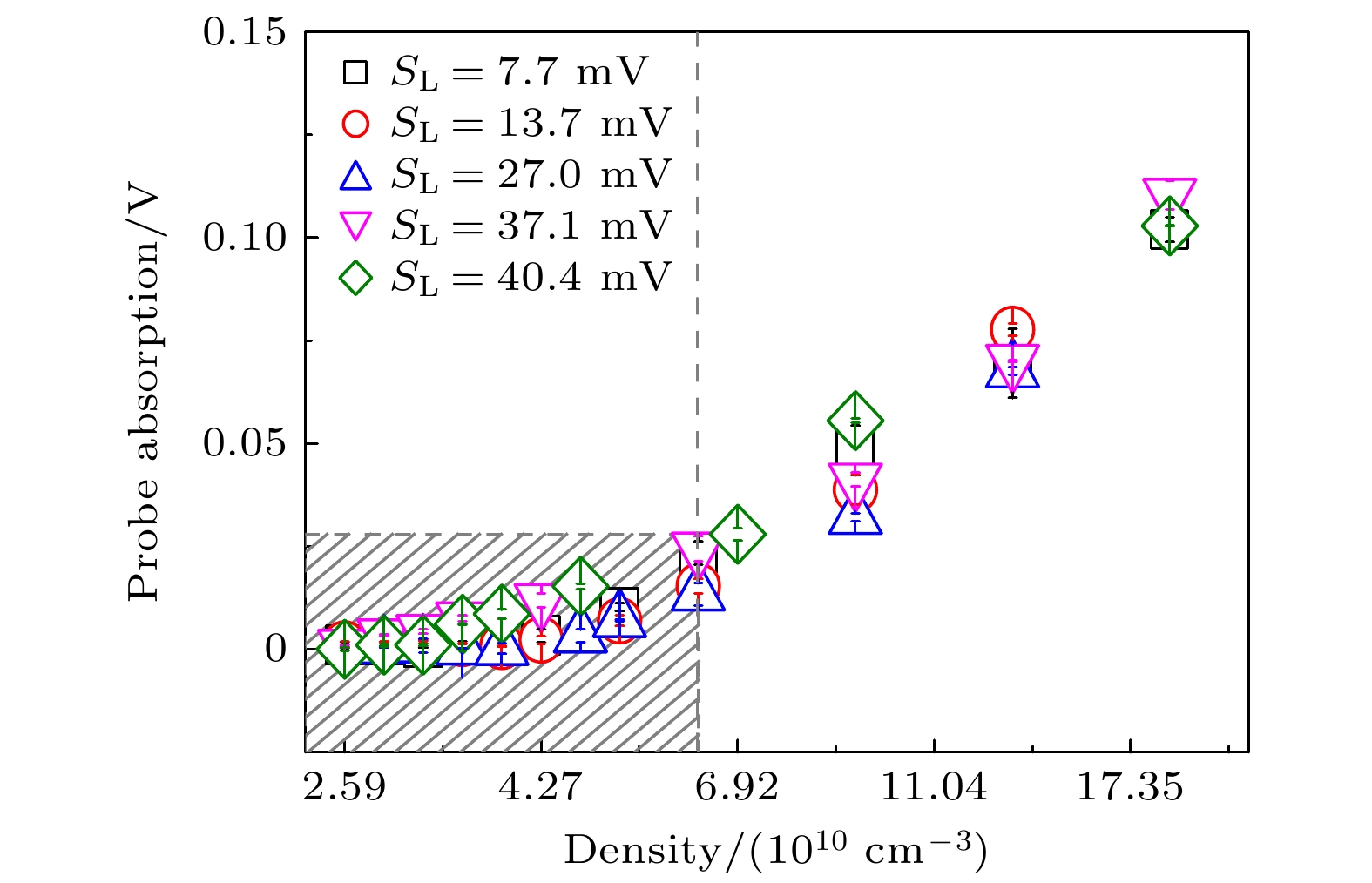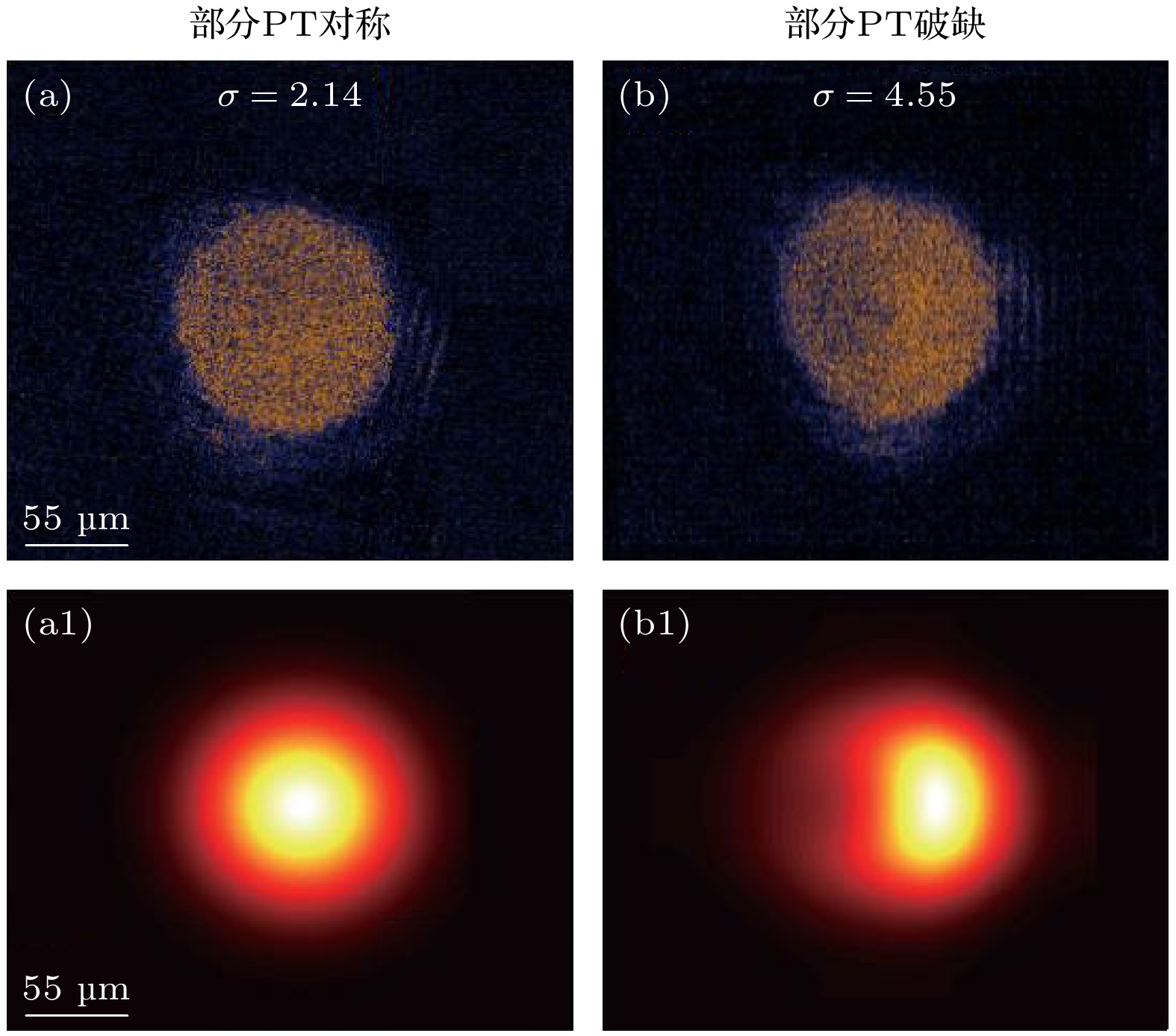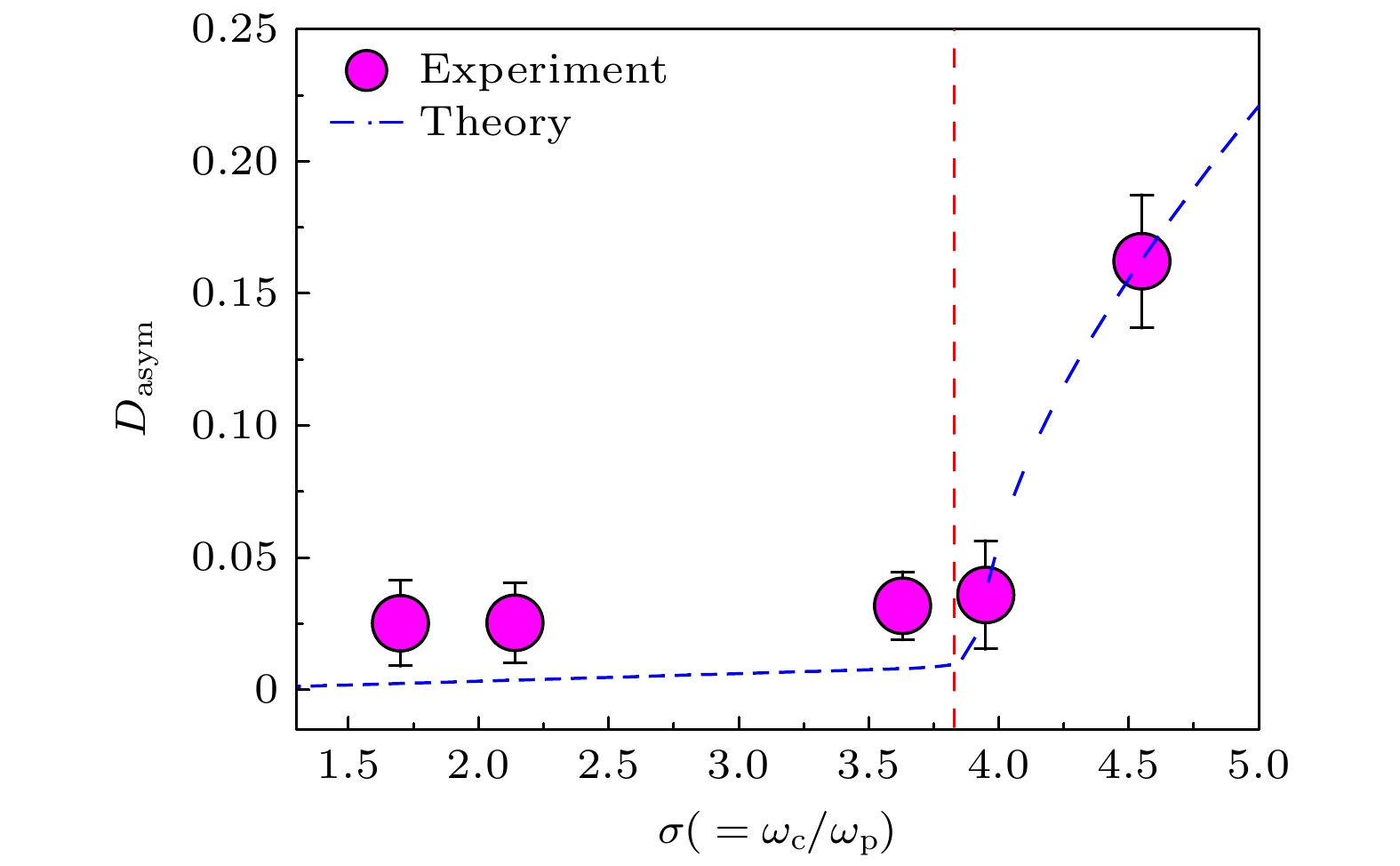-
Parity-time (PT) in atomic systems is of great significance for exploring exotic phenomena in non-Hermitian physics and non-Hermitian systems. It has been found that if PT symmetry is satisfied only in a certain spatial direction, then the Hamiltonian of the system still has a spectrum with eigenvalues of real numbers, which is called partial PT symmetry. In this paper, we use a Λ-type three-level atomic system, which is composed of two ground states $\left| {6{{\mathrm{S}}_{1/2}}, F = 3} \right\rangle $,$\left| {6{{\mathrm{P}}_{3/2}}, F' = 4} \right\rangle $and an excited state $\left| {6{{\mathrm{P}}_{3/2}}, F' = 4} \right\rangle $of cesium atom, to investigate the partial PT symmetry. A probe laser with the detuning of Δ3 = 607 MHz and a coupling laser satisfy the condition of two-photon Raman absorption of cesium atom, forming a loss channel. In order to construct the gain channel, we add the repumping laser that resonates during the transition of $\left| {6{{\mathrm{S}}_{1/2}}, F = 3} \right\rangle $to $\left| {6{{\mathrm{P}}_{3/2}}, F' = 4} \right\rangle $, changing the population of the two ground state energy levels, thus reducing the absorption of the Λ level system and forming the gain channel of the atomic system under certain conditions. In order to obtain the equilibrium condition of the partial PT-symmetric system, firstly, the light spot of the repumping laser in the experiment is covered by the probe laser, and then the repumping laser is moved to overlap with half of the probe laser of the detection light. When the gain and loss are balanced, the partial PT-symmetric system is in equilibrium. By changing the beam-waist ratio σ of the coupling laser to the probe laser, the transition from symmetry to broken phase is observed in partial PT-symmetric systems. By measuring the asymmetry of the detection-beam intensity distribution Dasym, we can accurately determine the partial PT symmetry breaking point, and the breaking point is located at $\sigma = {\sigma _{{\mathrm{cr}}}} \approx 3.8$. The theoretical calculations are in good agreement with the experimental measurements. The results of partial PT symmetry and its phase transition, reported in this study, open up a way to actively manipulate multidimensional laser beams in non-Hermitian systems and have potential applications in the design of optical devices for laser amplification and attenuation in different parts of the laser. -
Keywords:
- partial PT symmetry /
- gain and loss /
- PT symmetry broken
[1] Bender C M, Boettcher S 1998 Phys. Rev. Lett. 80 5243
 Google Scholar
Google Scholar
[2] Bender C M 2005 Contemp. Phys. 46 277
 Google Scholar
Google Scholar
[3] Klaiman S, Cederbaum L S 2008 Phys. Rev. A 78 062113
 Google Scholar
Google Scholar
[4] El-Ganainy R, Makris K G, Khajavikhan M, Musslimani Z H, Rotter S Christodoulides D N 2018 Nat. Phys. 14 11
 Google Scholar
Google Scholar
[5] Ashida Y, Gong Z, Ueda M 2020 Adv. Phys. 69 249
 Google Scholar
Google Scholar
[6] Konotop V V, Shchesnovich V S, Zezyulin D A 2012 Phys. Lett. A 376 2750
 Google Scholar
Google Scholar
[7] Szameit A, Rechtsman M C, Bahat-Treidel O, Segev M 2011 Phys. Rev. A 84 021806(R
 Google Scholar
Google Scholar
[8] Feng L, Ayache M, Huang J, Xu Y L, Lu M H, Chen Y F, Fainman Y, Scherer A 2011 Science 333 729
 Google Scholar
Google Scholar
[9] Regensburger A, Bersch C, Miri M, Onishchukov G, Christodoulides D N, Peschel U 2012 Nat. Phys. 488 167
 Google Scholar
Google Scholar
[10] Peng B, Özdemir S K, Lei F, Monifi F, Gianfreda M, Long G L, Fan S, Nori F, Bender C M, Yang L 2014 Nat. Phys. 10 394
 Google Scholar
Google Scholar
[11] Wen J M, Jiang X, Jiang L, Xiao M 2018 J. Phys. B: At. Mol. Opt. Phys. 51 222001
 Google Scholar
Google Scholar
[12] Hang C, Huang G X, Konotop V V 2013 Phys. Rev. Lett. 110 083604
 Google Scholar
Google Scholar
[13] Peng P, Cao W C, Shen C, Qu W Z, Wen J M, Jiang L, Xiao Y H 2016 Nat. Phys. 12 1139
 Google Scholar
Google Scholar
[14] Jiang Y, Mei Y F, Zuo Y, Zhai Y H, Li J S, Wen J M, Du S W 2019 Phys. Rev. Lett. 123 193604
 Google Scholar
Google Scholar
[15] Zhang Z Y, Zhang Y Q, Sheng J T, Yang L, Miri M A, Christodoulides D N, He B, Zhang Y P, Xiao M 2016 Phys. Rev. Lett. 117 123601
 Google Scholar
Google Scholar
[16] Zhang Z Y, Feng Y, Ning S H, Malpuech G, Solnyshkov D D, Xu Z F, Zhang Y P, Xiao M 2022 Photonics Res. 10 958
 Google Scholar
Google Scholar
[17] Feng Y, Liu Z Z, Liu F, Yu J W, Liang S, Li F, Zhang Y P, Xiao M, Zhang Z Y 2023 Phys. Rev. Lett. 131 013802
 Google Scholar
Google Scholar
[18] Zhang Z Y, Liang S, Septembre I, Yu J W, Huang Y P, Liu M C, Zhang Y P, Xiao M, Malpuech G, Solnyshkov D 2024 Phys. Rev. Lett. 132 263801
 Google Scholar
Google Scholar
[19] Miri M A, Alù A 2019 Science 363 7709
 Google Scholar
Google Scholar
[20] Chong Y D, Ge L, Stone A D 2011 Phys. Rev. Lett. 106 093902
 Google Scholar
Google Scholar
[21] Xiao L, Zhan X, Bian Z H, Wang K K, Zhang X, Wang X P, Li J, Mochizuki K, Kim D, Kawakami N, Yi W, Obuse H, Sanders B C, Xue P 2017 Nat. Phys. 13 1117
 Google Scholar
Google Scholar
[22] Zhang J, Peng B, Özdemir S K, Pichler K, Krimer D O, Zhao G M, Nori F, Liu Y X, Rotter S, Yang L 2018 Nat. Photonics 12 479
 Google Scholar
Google Scholar
[23] Shui T, Yang W X, Liu S P, Li L, Zhu Z H 2018 Phys. Rev. A 97 033819
 Google Scholar
Google Scholar
[24] Li J M, Harter A K, Liu J, de Melo L, Joglekar Y N, Luo L 2019 Nat. Commun. 10 855
 Google Scholar
Google Scholar
[25] Xiao L, Deng T S, Wang K K, Zhu G Y, Wang Z, Yi W, Xue P 2020 Nat. Phys. 16 761
 Google Scholar
Google Scholar
[26] Xiao L, Deng T S, Wang K K, Wang Z, Yi W, Xue P 2021 Phys. Rev. Lett. 126 230402
 Google Scholar
Google Scholar
[27] 唐原江, 梁超, 刘永椿 2022 物理学报 71 171101
 Google Scholar
Google Scholar
Tang Y J, Liang C, Liu Y C 2022 Acta Phys. Sin. 71 171101
 Google Scholar
Google Scholar
[28] Yang J 2014 Opt. Lett. 39 1133
 Google Scholar
Google Scholar
[29] Kartashov Y V, Konotop V V, Torner L 2015 Phys. Rev. Lett. 115 193902
 Google Scholar
Google Scholar
[30] Wang H, Huang J, Ren X, Weng Y, Mihalache D, He Y 2018 Rom. J. Phys. 63 205
[31] Ge L, Stone A D 2014 Phys. Rev. X 4 031011
 Google Scholar
Google Scholar
[32] Xue Y M, Hang C, He Y H, Bai Z Y, Jiao Y C, Huang G X, Zhao J M, Jia S T 2022 Phys. Rev. A 105 053516
 Google Scholar
Google Scholar
-
图 1 (a) 实验装置示意图. (b)铯原子气室中探测光、耦合光和泵浦光横截面. 探测光和耦合光为圆形高斯光斑, 泵浦光设计为椭圆形高斯光斑, 与探测光和耦合光的一半重合, 形成二维部分PT对称的损耗和增益通道. (c)铯原子基态和激发态三能级构成部分PT系统中损耗(左)与增益通道(右)的能级示意图, Ωp, Ωc和 Ωr为Rabi频率, Δ2和Δ3分别为激光束的频率失谐
Figure 1. (a) Sketch of the experimental setup. (b) The probe and coupling laser are circular Gaussian, and the repumping laser is designed as elliptical Gaussian, the coupling laser covers the whole probe beam, whereas the repumping laser covers the right-half region of the probe beam, which creates a 2D partially PT-symmetric potential for the probe laser. (c) Energy level diagram of loss and gain channels in the three-level component PT system of cesium atoms, the left and right panels show the loss and gain configurations, respectively; Ωp, Ωc and Ωr are Rabi frequencies and Δ2 and Δ3 are frequency detuning of laser beam.
图 2 (a) Λ型三能级原子系统中的损耗p + c (紫色)与增益p + c + r (红色)的光谱; (b)测量增益和损耗对应的PD 信号, p代表频率远离失谐的情况; p + c对应探测光与耦合光共同作用的结果; p + c + r对应的是3束光同时存在的情况. 此时泵浦光与探测光的光斑完全重叠; (c) 部分PT系统处于平衡位置时探测光增益和损耗分别对应的电平信号, 移动泵浦光的光斑与探测光光斑的一半重合, 此时对应的信号p + c + r与p 完全重合
Figure 2. (a) Spectra of loss p + c (purple) and gain p + c + r (red) in a Λ-type three-level atomic system; (b) the measurements of PD signals for the gain and loss of the probe laser, the signal p corresponds to that the probe laser with the frequency far detuning from the resonance; p + c corresponds to that the probe laser propagates in the atoms driven only by the coupling laser; p + c + r corresponds to that the probe laser propagates in the atoms driven by both coupling and repumping lasers, repumping laser is fully overlapped with the probe beam, which the signals p + c + r and p + c are located symmetrically about the signal p; (c) the repumping laser is then moved to behalf overlapped with the probe beam, in which the signal p + c + r coincides with the signal p.
图 3 实验测量初始损耗间隔分别为SL = 7.7, 13.7, 27.0, 37.1和40.4 mV时, 增益SGL与原子密度ρ的关系, 灰色虚线左边代表的是部分PT对称区域, 右边是部分PT对称破坏区域, 误差棒是两次测量的标准偏差
Figure 3. (a) Relationship between the gain SGL and the atomic density when the initial loss interval is SL = 7.7, 13.7, 27.0, 37.1 and 40.4 mV, respectively, the gray dotted line on the left represents a partial PT symmetry region, and on the right is a non-partial PT-symmetry region, error bars denote standard error of two measurements.
图 4 (a) 耦合光与探测光的腰斑比$ \sigma = 2.14 $, 系统处于部分PT对称区域时对应的探测光的光斑是均匀分布, 对应的理论模拟结果(a1); (b) 耦合光与探测光的腰斑比$ \sigma = $$ 4.55 $时, 探测光光斑分布呈现不均匀的分布, 且左半边暗右半边亮, 此时系统处于PT破缺, 对应的理论模拟(b1)
Figure 4. (a) Measured result for $ \sigma = 2.14 $ of the probe intensity distribution, which is uniform, and the numerical results corresponding to panel (a1). (b) Measured result for $\sigma = 4.55$ of the partial PT symmetry broken, and the numerical results corresponding to panel (b1).
图 5 探测光的光斑不对称度Dasym与耦合光和探测光的腰斑比σ的依赖关系, 可以看到部分PT破缺点的位置是σ = σcr ≈ 3.8, 玫红色圆圈是实验测量结果, 蓝色虚线是理论计算结果, 红色虚线左边代表的是部分PT对称区域, 右边是部分PT对称破缺区域, 误差棒是5次测量的标准偏差
Figure 5. Experimental measurements (magenta circle) and calculations (blue line) of Dasym as a function of beam-waist ratio σ, where the EP locates at σ = σcr ≈ 3.8, the red dotted line represents the partial PT symmetry region on the left and the partial PT symmetry broken region on the right, error bars denote standard error of five measurements.
-
[1] Bender C M, Boettcher S 1998 Phys. Rev. Lett. 80 5243
 Google Scholar
Google Scholar
[2] Bender C M 2005 Contemp. Phys. 46 277
 Google Scholar
Google Scholar
[3] Klaiman S, Cederbaum L S 2008 Phys. Rev. A 78 062113
 Google Scholar
Google Scholar
[4] El-Ganainy R, Makris K G, Khajavikhan M, Musslimani Z H, Rotter S Christodoulides D N 2018 Nat. Phys. 14 11
 Google Scholar
Google Scholar
[5] Ashida Y, Gong Z, Ueda M 2020 Adv. Phys. 69 249
 Google Scholar
Google Scholar
[6] Konotop V V, Shchesnovich V S, Zezyulin D A 2012 Phys. Lett. A 376 2750
 Google Scholar
Google Scholar
[7] Szameit A, Rechtsman M C, Bahat-Treidel O, Segev M 2011 Phys. Rev. A 84 021806(R
 Google Scholar
Google Scholar
[8] Feng L, Ayache M, Huang J, Xu Y L, Lu M H, Chen Y F, Fainman Y, Scherer A 2011 Science 333 729
 Google Scholar
Google Scholar
[9] Regensburger A, Bersch C, Miri M, Onishchukov G, Christodoulides D N, Peschel U 2012 Nat. Phys. 488 167
 Google Scholar
Google Scholar
[10] Peng B, Özdemir S K, Lei F, Monifi F, Gianfreda M, Long G L, Fan S, Nori F, Bender C M, Yang L 2014 Nat. Phys. 10 394
 Google Scholar
Google Scholar
[11] Wen J M, Jiang X, Jiang L, Xiao M 2018 J. Phys. B: At. Mol. Opt. Phys. 51 222001
 Google Scholar
Google Scholar
[12] Hang C, Huang G X, Konotop V V 2013 Phys. Rev. Lett. 110 083604
 Google Scholar
Google Scholar
[13] Peng P, Cao W C, Shen C, Qu W Z, Wen J M, Jiang L, Xiao Y H 2016 Nat. Phys. 12 1139
 Google Scholar
Google Scholar
[14] Jiang Y, Mei Y F, Zuo Y, Zhai Y H, Li J S, Wen J M, Du S W 2019 Phys. Rev. Lett. 123 193604
 Google Scholar
Google Scholar
[15] Zhang Z Y, Zhang Y Q, Sheng J T, Yang L, Miri M A, Christodoulides D N, He B, Zhang Y P, Xiao M 2016 Phys. Rev. Lett. 117 123601
 Google Scholar
Google Scholar
[16] Zhang Z Y, Feng Y, Ning S H, Malpuech G, Solnyshkov D D, Xu Z F, Zhang Y P, Xiao M 2022 Photonics Res. 10 958
 Google Scholar
Google Scholar
[17] Feng Y, Liu Z Z, Liu F, Yu J W, Liang S, Li F, Zhang Y P, Xiao M, Zhang Z Y 2023 Phys. Rev. Lett. 131 013802
 Google Scholar
Google Scholar
[18] Zhang Z Y, Liang S, Septembre I, Yu J W, Huang Y P, Liu M C, Zhang Y P, Xiao M, Malpuech G, Solnyshkov D 2024 Phys. Rev. Lett. 132 263801
 Google Scholar
Google Scholar
[19] Miri M A, Alù A 2019 Science 363 7709
 Google Scholar
Google Scholar
[20] Chong Y D, Ge L, Stone A D 2011 Phys. Rev. Lett. 106 093902
 Google Scholar
Google Scholar
[21] Xiao L, Zhan X, Bian Z H, Wang K K, Zhang X, Wang X P, Li J, Mochizuki K, Kim D, Kawakami N, Yi W, Obuse H, Sanders B C, Xue P 2017 Nat. Phys. 13 1117
 Google Scholar
Google Scholar
[22] Zhang J, Peng B, Özdemir S K, Pichler K, Krimer D O, Zhao G M, Nori F, Liu Y X, Rotter S, Yang L 2018 Nat. Photonics 12 479
 Google Scholar
Google Scholar
[23] Shui T, Yang W X, Liu S P, Li L, Zhu Z H 2018 Phys. Rev. A 97 033819
 Google Scholar
Google Scholar
[24] Li J M, Harter A K, Liu J, de Melo L, Joglekar Y N, Luo L 2019 Nat. Commun. 10 855
 Google Scholar
Google Scholar
[25] Xiao L, Deng T S, Wang K K, Zhu G Y, Wang Z, Yi W, Xue P 2020 Nat. Phys. 16 761
 Google Scholar
Google Scholar
[26] Xiao L, Deng T S, Wang K K, Wang Z, Yi W, Xue P 2021 Phys. Rev. Lett. 126 230402
 Google Scholar
Google Scholar
[27] 唐原江, 梁超, 刘永椿 2022 物理学报 71 171101
 Google Scholar
Google Scholar
Tang Y J, Liang C, Liu Y C 2022 Acta Phys. Sin. 71 171101
 Google Scholar
Google Scholar
[28] Yang J 2014 Opt. Lett. 39 1133
 Google Scholar
Google Scholar
[29] Kartashov Y V, Konotop V V, Torner L 2015 Phys. Rev. Lett. 115 193902
 Google Scholar
Google Scholar
[30] Wang H, Huang J, Ren X, Weng Y, Mihalache D, He Y 2018 Rom. J. Phys. 63 205
[31] Ge L, Stone A D 2014 Phys. Rev. X 4 031011
 Google Scholar
Google Scholar
[32] Xue Y M, Hang C, He Y H, Bai Z Y, Jiao Y C, Huang G X, Zhao J M, Jia S T 2022 Phys. Rev. A 105 053516
 Google Scholar
Google Scholar
Catalog
Metrics
- Abstract views: 6483
- PDF Downloads: 100
- Cited By: 0















 DownLoad:
DownLoad:




